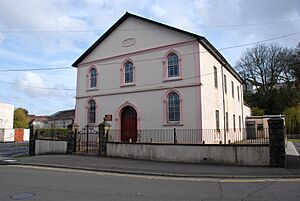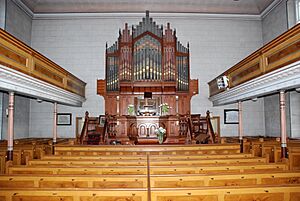Siloa Chapel, Aberdare facts for kids
Quick facts for kids Siloa Welsh Independent Chapel |
|
|---|---|
 |
|
| Location | Green Street, Aberdare |
| Country | Wales, United Kingdom |
| Denomination | Independent (Congregationalist) |
| History | |
| Founded | 1841 |
| Architecture | |
| Architectural type | Chapel |
| Style | Early 19th century |
| Completed | 1844 |
| Specifications | |
| Capacity | 900 |
Siloa Chapel was once the biggest Welsh Independent chapel in Aberdare, Wales. Independent chapels are a type of Christian church where each congregation makes its own decisions. Services at Siloa are held in the Welsh language. Founded in 1844, Siloa is one of the few Welsh-speaking chapels in the area that is still open today. It is famous for having only three main ministers in over a hundred years: David Price (1843–1878), D. Silyn Evans (1880–1930), and R. Ifor Parry (1933–1964).
Contents
How Siloa Chapel Started
In 1841, a minister named Thomas Rees from Ebenezer, Trecynon chapel started a Sunday school in Aberdare. He also began preaching in English, hoping to start an English-speaking church. When Rees moved away in 1842, the idea for an English church was dropped.
However, a small group from Ebenezer chapel kept meeting, but in Welsh. A key person was David Price, who had just moved to Aberdare. He helped arrange meetings in a room at the Boot Inn in Aberdare.
In 1843, fourteen members from Ebenezer, the oldest independent church nearby, asked to leave and start a new church. Their request was approved, and the new church was named Siloa. This name honored their former minister's new church in Llanelli. David Price was one of the original members and helped build the first chapel. The first building cost £600.
David Price's Time as Minister (1843–1878)
Soon after, David Price became the minister at Siloa. He also managed the chapel's money for many years. Price had started his life as a miner. During the Aberdare Strike of 1857–1858, he spoke alongside Henry Austin Bruce. Price translated Bruce's words into Welsh and shared his own experiences as a young miner during a strike. He tried to convince the miners to go back to work. His views showed that many nonconformist leaders at the time did not support trade unions.
Siloa Chapel was built when Aberdare was growing fast. This was because of the booming coal mining industry. During Price's time as minister, many people moved to Aberdare. They came from rural areas like Carmarthenshire and Pembrokeshire. This led to a huge increase in Siloa's members, reaching over 600 by the 1860s. This made it the biggest church in the valley.
The number of members also grew a lot after the Religious Revival of 1849. Because of this, Siloa was rebuilt and made bigger in 1855, costing £719. After another Religious Revival in 1859, membership increased again, and all the building debts were paid off by 1860.
Siloa played an important part in the rise of political change in the 1800s. This movement was closely linked to nonconformist churches. In 1848, a big meeting was held at Siloa. It was led by David Williams, also known as Alaw Goch. The meeting protested against reports about education in Wales from 1847. These reports were seen as unfair to Welsh people.
Several new churches were started from Siloa because of Price's efforts. These included Bethesda in Abernant and Bryn Seion in Cwmbach. Members of Siloa also helped start churches in Mountain Ash, Aberaman, Cwmaman, and Cwmdare.
In 1866, the church members gave Price £170 as a gift. This was to thank him for all his hard work. Price passed away in 1878 when he was 68 years old.
Silyn Evans's Time as Minister (1880–1930)
Silyn Evans took over from David Price as minister. He later wrote a book about Price's life.
Siloa had 661 members in 1899. After the Religious Revival of 1904–1905, this number grew to 761 by 1907.
The chapel was greatly renovated in 1890, costing £1,100. Services to celebrate paying off these debts were held in January 1905. This happened at the same time as the Revival.
By 1923, the number of members had dropped to 645.
Siloa Chapel in the 20th Century
In 1933, when R. Ifor Parry became minister, Siloa had 501 members. By 1954, the number had fallen to 363. There was a further sharp drop by 1961, when Parry left his ministry.
In August 1969, Reverend Aneurin Owen Roberts became the minister of Siloa. Services continued in Welsh, and the number of members stayed steady for some years. Families were especially welcomed, and children helped lead one Sunday morning service each month. Reverend Roberts was the main organizer for the 100-year celebrations of the Côr Mawr Caradog choir in October 1972.
However, the decline in chapel membership that was happening across Wales continued. Since 1980, services have been held in the smaller vestry room. This is because fewer people attend. Unlike other churches in the valley, Siloa has continued to be a Welsh-language church. This is true even after Reverend Roberts, Siloa's last full-time minister, retired in 1987.


